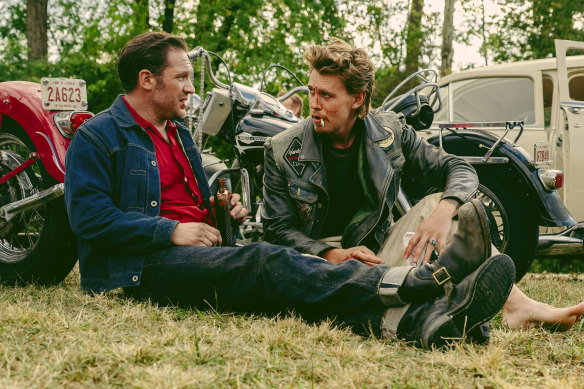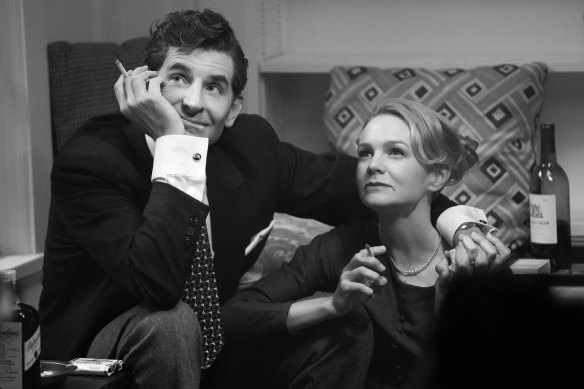By Meg Watson
While fewer Australians are smoking than ever, cigarettes are everywhere on our film and TV screens with Hollywood seemingly re-embracing the glamorisation of tobacco that helped drive last century’s sky-high smoking rates.
From Austin Butler chain-smoking outside Jodie Comer’s house in The Bikeriders to Josh O’Connor taking long drags on the beach while staring longingly at Zendaya in Challengers, cigarettes feel inescapable at the cinema. Just one of the 10 best picture nominees at this year’s Oscars didn’t feature smoking: Barbie.

Tom Hardy (left) and Austin Butler are members of the Vandals motorcycle club in The Bikeriders.Credit: AP
And things aren’t so different on TV. A recent report from US anti-smoking group Truth Initiative shows more than half of the streaming series most popular with Americans aged 15-24 in 2022 featured smoking, and the number of on-screen depictions rose 110 per cent from 2021.
The report doesn’t classify how many are positive depictions, but health advocates are wary of a trend towards glamorisation.
“Research clearly shows that young people who are more exposed to imagery of smoking are more likely to have positive attitudes about smoking and are more likely to smoke as well,” says Becky Freeman, an associate professor from the University of Sydney’s School of Public Health.
Though youth smoking rates in Australia remain very low, the rate of vaping has tripled in the past few years – and cigarettes still have a cultural allure with younger celebs like Jeremy Allen White and Paul Mescal recently going viral for lighting up offscreen.
“All these stars are hanging out and openly smoking. It’s such a throwback to the ’90s!” Freeman says.
Did Hollywood ever really quit smoking?
Hollywood has a long history with cigarettes, both commercially and artistically. In the 1930s and ’40s, film stars frequently promoted cigarette brands thanks to mutually beneficial deals brokered by major studios. Then tobacco companies started funnelling money into TV, sponsoring popular series like The Flintstones.
Top 2022 TV shows popular with young people, ranked by tobacco incidents
- Dahmer - Monster: The Jeffrey Dahmer Story - 306
- Euphoria - 200
- The Simpsons - 195
- Stranger Things - 89
- The Walking Dead - 47
- Family Guy - 38
- Bob’s Burgers - 8
- Law and Order SVU - 7
Source: Truth Initiative’s While You Were Streaming 2023 report (released March 2024)
Regulation in the US and Australia stopped this in the early 1970s, but it took decades before legislators cracked down on product placement. From Superman busting out of a Marlboro truck in Superman II (1980) to James Bond carrying Lark cigarettes in License to Kill (1989), Big Tobacco spent millions glamorising their wares.
By the early 2000s, advertising was banned, smoking rates were declining, and attention turned to the next generation. Following external pressure, most major studios instituted policies discouraging tobacco use in work available to young audiences. It’s the reason Emma Stone’s Cruella and Colin Farrell’s Penguin in The Batman recently lost their iconic cigarettes and cigars.

Cruella’s iconic cigarette holder and plume of smoke was purposefully missing in Disney’s 2021 film. Credit:
However, these policies also allow scope for historical accuracy and what’s referred to as “creative justification”.
Smoking can signify a lot about a character, and there’s a rich cinematic history that informs our understanding of that. In The Bikeriders, rated M and set in the 1960s, Butler channels James Dean and Marlon Brando – iconic renegades with cigarettes fastened to their lips. And it’s far from the only film purposefully using cigarettes to connote the past.
The nostalgia factor
Just two of the ten 2024 best picture nominees took place in present day, and Maestro and Oppenheimer were centred on historical figures who were heavy smokers. (Although neither includes the fact both Leonard Bernstein and Robert Oppenheimer died of smoking-related illnesses). It stands to reason there would be significant tobacco usage in 1920s Oaklahoma in Killers of the Flower Moon and a 1970s boarding school in The Holdovers.

Bradley Cooper and Carey Mulligan in Maestro.Credit: Alamy Stock Photo
Saltburn director Emerald Fennell also recently told Vanity Fair she used smoking to timestamp her movie in 2006, before the UK banned smoking indoors. “For anyone in their 20s now or their teens now, that’s unfathomable that you could go to a bar or a pub and smoke a cigarette,” she said. “[With smoking] it becomes a sort of period drama.”
Of course, when the film became a streaming hit, that then exposed those young audiences to lavish images of current it boys Jacob Elordi and Barry Keoghan smoking cigarettes in the sun.
Is that a problem? “If there’s tobacco industry involvement [in any kind of on-screen smoking], that’s a very clear line for me,” Freeman says. “We do not allow the tobacco industry to pay for advertising.” Beyond that, it’s complicated: “I’m not in the business of telling artists how to do their art.”
However, she does feel it needs close monitoring and potential action . That could be the inclusion of quit lines or content warnings – as is mandated in other countries like India – or changes to content ratings.
“We think it’s important to protect young people from violence and sexual imagery that’s not appropriate for their age. Protecting them from exposure to glamorised images of smoking should be part of that.”
Our Breaking News Alert will notify you of significant breaking news when it happens. Get it here.